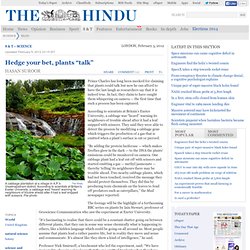

How Trees Communicate (Video) Sci-Tech / Science : Hedge your bet, plants “talk” The Hindu A cabbage plantation at a village in A.P.'s Visakhapatnam district.

According to scientists at Britain's Exeter University, a cabbage was “heard” warning its neighbours of trouble ahead after it had a leaf snipped with scissors. File photo Prince Charles has long been mocked for claiming that plants could talk but now he can afford to have the last laugh as researchers say that it is indeed true. In fact, they claim to have caught them whispering on camera — the first time that such a process has been captured. According to scientists at Britain's Exeter University, a cabbage was “heard'' warning its neighbours of trouble ahead after it had a leaf snipped with scissors. “By adding the protein luciferase — which makes fireflies glow in the dark — to the DNA the plants' emissions could be monitored on camera. The footage will be the highlight of a forthcoming BBC series on plants by Iain Stewart, professor of Geoscience Communication who saw the experiment at Exeter University.
Plants can think and perform computations, say scientists. Move over elephants: Mimosas have memories too. Not long after publishing a paper in a prestigious journal about plants being able to 'talk' using sound, Monica Gagliano is back with her new findings showing that they can 'learn'.

While this may sound stranger than fiction, Dr Gagliano, an Australian Research Council research fellow at The University of Western Australia's Centre for Evolutionary Biology, has solid evidence to support her theories, the latest of which is published in Oecologia. Her work is becoming famous, with a recent mention by Michael Pollan in the New Yorker. Her new article - written with Associate Professor Michael Renton and Dr Martial Depczynski from UWA's School of Plant Biology and Oceans Institute respectively, and Professor Stefano Mancuso at the University of Florence in Italy - is titled "Experience teaches plants to learn faster and forget slower in environments where it matters". Explore further: Get touchy feely with plants. The Secret Language of Plants. Up in the northern Sierra Nevada, the ecologist Richard Karban is trying to learn an alien language.

The sagebrush plants that dot these slopes speak to one another, using words no human knows. Karban, who teaches at the University of California, Davis, is listening in, and he’s beginning to understand what they say. The evidence for plant communication is only a few decades old, but in that short time it has leapfrogged from electrifying discovery to decisive debunking to resurrection. Two studies published in 1983 demonstrated that willow trees, poplars and sugar maples can warn each other about insect attacks: Intact, undamaged trees near ones that are infested with hungry bugs begin pumping out bug-repelling chemicals to ward off attack.
They somehow know what their neighbors are experiencing, and react to it. Richard Karban Richard Karban, an ecologist at the University of California, Davis, studies how sagebrush communicate. Secret Lives That reception made many scientists nervous. The smell of freshly-cut grass is actually a plant distress call. Fungus network 'plays role in plant communication' 10 May 2013Last updated at 03:10 ET Mycorrhizae are mutualistic - they both need and are needed by the plants whose roots they inhabit Plants can communicate the onset of an attack from aphids by making use of an underground network of fungi, researchers have found.

Instances of plant communication through the air have been documented, in which chemicals emitted by a damaged plant can be picked up by a neighbour. But below ground, most land plants are connected by fungi called mycorrhizae. The new study, published in Ecology Letters, demonstrates clearly that these fungi also aid in communication. It joins an established body of literature, recently reviewed in the Journal of Chemical Ecology and in Trends in Plant Science, which has suggested that the mycorrhizae can act as a kind of information network among plants. The team concerned themselves with aphids, tiny insects that feed on and damage plants. To prevent any through-the-air chemical communication, the plants were covered with bags. Fantastic Fungi: The Forbidden Fruit.